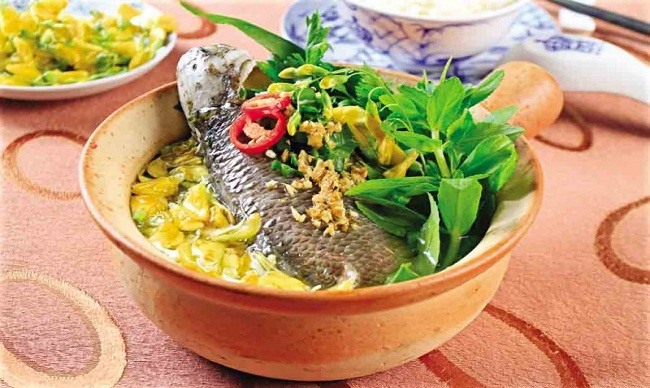Smelly but delicious: the dishes of Ninh Bình
 |
| Moss-eating fish: Tilapia broth is also a popular dish of locals in Ninh Bình, especially in Tổng Trường Yên (Tràng An now). Fish found in this area is firm and aromatic .- Photo dulichninhbinh365.com |
While Ninh Bình’s nature and landscape are famous among travelers – with Hoa Lư, the country’s former capital, Tràng An caves, world heritage Tam Cốc Bích Động limestone caves or the Vân Long swamp Hollywood movie site, not many know nem chua and mắm tép, the dishes that have been long associated with the lives of natives here.
Arriving in the village of Yên Mạc, one is intrigued by a string of houses selling this dish.
Fermented pork
Nem chua, fermented pork wrapped in banana leaf, looks very much like a greenish sausage. Opening the banana leaf emits a pleasing aroma of fermented pork blended with guava, generating homesickness among those raised in Ninh Bình.
Removing the greenish cover reveals the pinkish colour of pork with some shredded white skin.
The pork tastes a bit sour due to the fermentation process. It is served with dipping shrimp/ fish sauce, spiced with garlic and chilli.
Three other localities take pride in their fermented pork – the ancient city of Huế, Thanh Hóa and Phùng (former Hà Tây Province). Each has a unique taste. Unlike the fermented pork of the central province of Thanh Hóa and Huế City, which is made of ground pork, Yên Mạc fermented pork is made of sliced pork.
To make fermented pork, locals in Yên Mạc take out the fat and slice the lean pork. The slices are then soaked with thính (ground roasted rice) and wrapped in a cloth, which is squeezed remove any water left.
Sliced pork soaked with thính and shredded pork skin are then seasoned with salt.
The amount of thính and salt will decide the quality of the final product. If it is overseasoned, nem chua will be too sour, while lack of seasoning will prevent fermentation.
In summer, it takes one day to get pork fermented while in winter, it takes up to four days. Yên Mạc fermented pork is dipped in fish/shrimp sauce and eaten with some leaves like fig leaves, mơ (stinkvine) and đinh lăng (polyscias fruticosa) leaves.
Locals in Yên Mạc have a story about how the dish was born. It is said that in the Nguyễn dynasty, a resident of Yên Mô Thượng Village named Phạm Thận Duật worked in the royal court. He had a daughter with a passion for cooking. Phạm Thị Thư, seeing that drinking wine and eating Huế’s fermented pork was one of her father’s favourites, learned how to make this dish from the skillful chefs of the royal court.
When holding a party, this home-made fermented pork was a must for the father’s colleagues who were officials serving in the royal court. The dishes made by Thư were said to be even better than those served in the royal court.
When Thư came back her hometown in Ninh Bình, she passed down the know-how to Phạm Xủy, a great grandson of Duật. Xủy then opened a fermented pork eatery near Cầu Bút market and gradually his reputation spread to other provinces. Officials would always order Xủy’s fermented pork for their parties. Tourists passing by would also drop in to buy it and take back home as a gift.
There is an old saying that goes like this:
Yên Mạc đặc sản nem chua/ Tiệc tùng đình đám thường mua về dùng
“Fermented pork – Yên Mạc’s specialty/ Small or big parties often had it.”
Shrimp paste
About 40 kilometres from Yên Mạc village is Gia Viễn District, an area surrounded by the three rivers – Bôi, Đáy and Hoàng Long, a land famous for its limestone caves and swamps. Thanks to its river network, Gia Viễn residents have abundant tiny shrimp with which to make mắm tép,
Shrimp paste here is commonly used as a type of dipping sauce or added to stirfried pork. Those who do not want to use shrimp paste for dipping, can stir shrimp paste with boiling oil, and add dry onion slices, garlic and ginger.
Gia Viễn shrimp paste is made pretty much the same way as traditional shrimp sauce, yet the ingredients are quite different - locals in Gia Viễn make the paste from tiny shrimp.
The process is quite simple – thính, salt and water are added to shrimp, the mixture is then put into a terracotta pot within a month. The longer it is preserved, the higher quality the shrimp paste is.
Hoàng Minh Trang, a local resident, describes the process: “Making shrimp paste is not difficult but it requires care in every step and exact amounts of ingredients [thính and salt]. To make shrimp paste, we [Trang and her husband] had to wake up at as early as 1am to catch fresh tiny shrimp, which should be cleaned within two to three hours. Otherwise, the shrimp dies and that batch of shrimp paste would not meet our standard quality,” she said.
“I still remember our parents going to the river to pick up tép (tiny shrimp) and either sell them at market or to the families that make shrimp paste, or bring back home to make shrimp paste for family use,” said Đinh Thị Thành,
The tiny shrimp is in season in November and December, when the river water turns a bit unclear and muddy, said Thành.
These days one can catch three to five kilograms of shrimp, but the job is never easy as it requires shrimp catchers to stand five to eight hours in water, said Thành.
Ground rice
In roasting rice to make thính, one also needs to be patient, stiring the grains over a low heat. If overcooked, the groundthính will taste bitter and be useless.
“When I was small, I was so familiar with shrimp paste making procedures. But it was not easy for me the first times. It either smelled bad or was too salty. It took time to perfect the dish,” said Trần Thị Trang of Me town in Ninh Bình. Her family now makes about 700 litres of shrimp paste every month.
“Every step is important and requires meticulousness. To me, roasting thính for shrimp paste needs the most attention. We made thính from sticky rice that we grew ourselves. A good batch of roasted rice must be brown in colour and have an aromatic scent,” said Trang.
Shrimp paste is a popular and convenient dish because it can be kept for long periods of time and doesn’t need any preservatives. The longer it sits, the better the paste, said Thành.
Besides fermented pork and shrimp paste, tilapia broth is also a popular dish of locals, especially in Tổng Trường Yên (Tràng An now), as this fish is found in the caves of Tổng Trường Yên. Different from fish growing in other regions, tilapia here ate moss and grass and its flesh is firm and aromatic.
What the stars mean:
★ Poor ★ ★ Promising ★★★ Good ★★★★ Very good ★★★★★ Exceptional
Latest News
More News
- Cultivating agricultural tourism model in Hanoi (April 05, 2024 | 14:51)
- HCM City stimulates tourism with discounts up to 60 per cent (April 04, 2024 | 16:01)
- Visitors to Vietnam in first quarter exceeded pre-COVID numbers (April 03, 2024 | 16:42)
- Domestic tourism under threat from high flight costs (April 02, 2024 | 12:19)
- Travelling back to nature (April 02, 2024 | 11:50)
- An Giang launches smart tourism information portal (March 29, 2024 | 10:20)
- Hanoi voted as ‘Best Food Destination for 2024’ by TripAdvisor readers (March 29, 2024 | 10:08)
- AirAsia Cambodia ready to take off starting with three domestic destinations (March 19, 2024 | 18:27)
- Phu Quoc among top beach destinations in Asia (March 19, 2024 | 15:55)
- Favourable visa policy boosts tourism recovery (March 19, 2024 | 15:44)


















 Mobile Version
Mobile Version